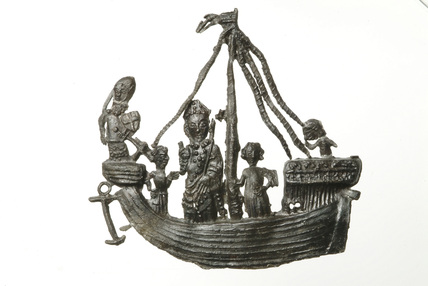This week has brought another round of meetings. However, on Wednesday I also managed to attend a fascinating lecture given by Professor Christopher Scull, organised by Dr Andy Seaman and Dr Darrell Rohl, as part of the staff-student archaeology seminar series at Canterbury Christ Church.
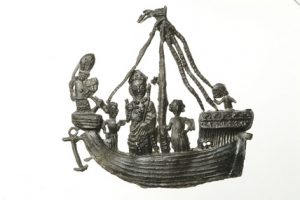
Professor Scull has been one of the leaders of the Rendlesham Project that has uncovered an internationally important Anglo-Saxon site. On one of his final slides in his fascinating presentation, he highlighted the critical importance of co-operation among a wide range of individuals and organisations, including local government authorities, both in terms of the archaeology in all its forms and the fate of the material culture unearthed during the archaeological work. For in terms of the latter, a selection of the finds are and will continue to be on display at Ipswich Museum. Although on a smaller scale, it is perhaps worth noting that Dover Museum has a display of finds from the recent archaeological excavations at Lyminge, the location of another exceedingly significant Anglo-Saxon site, in addition to finds supplied by Canterbury Archaeological Trust from its Dover excavations, some of which have featured in the blog over the last year or so.
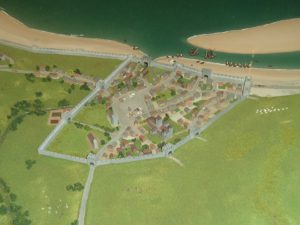
Model of Dover in c. 1535 in Dover Museum
This work of local museums is vital with respect to preserving, conserving, displaying and offering opportunities to study finds – for schoolchildren to university scholars and heritage professionals – and where appropriate other materials. Consequently, it was great to hear about what is happening in Suffolk because quite understandably such initiatives are under financial pressure in the present economic and political climate. Because in addition to the threat of imminent closure hanging over the City Council’s Canterbury Heritage Museum, a meeting I had attended earlier on Wednesday had highlighted this issue as one that Kent has already faced elsewhere, and is likely to continue to face within its ancient county boundary. Yet, as York and now Suffolk (and many other places nationally) are showing in different ways, as far as I can see this can also be a time of opportunity, an exciting chance for institutions, groups and individuals to co-operate with local authorities to find solutions to these pressures. Yes, there are indeed issues, but by working together solutions can be found regarding a communal-style way (through the formation of a Trust) of running overhauled and renewed museums, of maintaining and enhancing historic buildings, and of thinking about Canterbury’s history and heritage as a whole for the understanding, appreciation and enjoyment of all. Such ideas are not new. As a medieval historian, I’m aware of ideas about the body politic, and, even though medieval philosophers were certainly not thinking about museums, the sense that everyone mattered and needed to work together within a defined structure if the social body was to prosper is appropriate. Thus, if like me you think this idea of a Trust working with the City Council to keep a revamped Museum of Canterbury in the city is a worthwhile project and needs time for consideration, perhaps you would like to engage in the consultation process: https://www.ipetitions.com/petition/save-canterbury-heritage-museum
I’ll now return briefly to Christopher Scull’s lecture to give you a flavour of what he had to say to his audience of students, lecturers, professional and amateur archaeologists, and interested members of the general public. This site had come to the fore because the landowner had noticed the growth in illegal activities by metal detectorists who were apparently homing in on his fields at night. Being just to the north east of Sutton Hoo and on the River Deben, the area had been noted as potentially important archaeologically and there had been a small excavation in 1982. Nevertheless, nothing happened until 2008 when the farmer alerted various archaeological, educational and local government organisations, and gave his blessing to the undertaking of archaeological work on his land. Much of this used non-invasive techniques, such as the systematic work of responsible metal detectorists who covered a large area of 150 hectares twice. In addition, the same fields were investigated using field walking in order to gain the greatest coverage concerning both metal and pottery finds. This work focused on the disturbed top layer of the plough soils and brought to light almost 4,000 finds, each of which was entered into a comprehensive and what has become an invaluable database. Other work has also taken place over almost a decade, including the use of further non-invasive methods, as well as full archaeological excavations at locations that the team had identified as potentially the most important.
Bringing all of this information together has been a major task, but in some ways it is the metal finds – variety, type, range in quality, and the presence of specific coins, that have been the key to understanding the site’s history, and most particularly the build-up and then its zenith between the 6th and 8th centuries. Thus, Professor Scull and his colleagues believe that it was indeed a royal settlement, including a ‘palace’, its position on either side of the river valley on higher land placing it on the boundary between different soil types/topography and consequently farming systems. Such a location offered those in authority in Anglo-Saxon Suffolk (East Anglia) opportunities to extract tribute, to trade inland, along the coast and much further afield – the presence of Byzantine coinage suggests 6th- and 7th-century mercantile activity. Furthermore, rulers used such sites to dispense justice, and Professor Scull posited the idea that a tented village may have formed around the permanent settlement a couple of times a year when subordinates gathered at the king’s command. The exact role of the Church (as institution and building, the parish church is dedicated to St Gregory the Great) in the settlement’s history during this period is less clear. One idea is that at some point it similarly may have been an ecclesiastical centre or minster, not least because Bede mentions Cedd performed the baptism of Swithelm, Sigeberht’s successor and the son of Seaxbald at a royal place called Rendlesham, although exactly where is not stated.
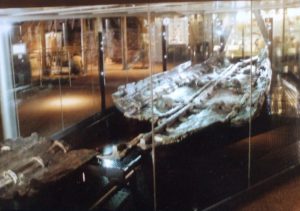
Dover Museum – Dover Bronze Age boat gallery
The final meeting I want to mention took place yesterday. Dr Martin Watts and I met Dr Elizabeth Edwards, a former lecturer at the University of Kent where she led the part-time History degree programme (and like me she is a Council member of Kent Archaeological Society), Stuart Bligh from the National Maritime Museum at Greenwich and Professor Sarah Palmer, who founded the Greenwich Maritime Institute. Stuart had contacted me towards the end of last year about the potential for a collection of essays on ‘Maritime Kent’. Cornwall has such a volume and Kent seems an equally appropriate county for a study of this kind. Again, this highlights the value of co-operation between organisations, in this case the county’s three universities and the nationally/internationally important museum at Greenwich. More about our ideas of the way forward anon, but at this stage it is worth saying that we think we will adopt a thematic structure chronologically that will work to tell the history of Kent’s place as a vital maritime county from prehistoric to modern times.
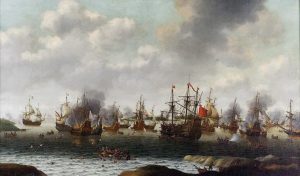
Raid on the Medway: https://en.wikipedia.org/wiki/Raid_on_the_Medway#/media/File:Van_Soest,_Attack_on_the_Medway.jpg
Beginning to plan such a work in 2017 is very apposite because it marks a significant anniversary of the Dutch Raid on the Medway in 1667. For those who are less familiar regarding this naval engagement, it has far more in common with Bannockburn than Agincourt! For as Dr Christopher Ware will recount on Saturday 1 April at the Tudors and Stuarts History Weekend in Canterbury, this naval encounter was one of the worst defeats the English Navy ever suffered. Christopher will also assess the English response, especially just what the Navy Board and leading men such as Sir William Batten and Samuel Pepys attempted to do to rationalise what was both a national and royal humiliation. I’m sure his talk will be fascinating, and if you would like to learn more about the history of the Royal Navy during this critical period, please see: https://www.canterbury.ac.uk/arts-and-humanities/school-of-humanities/tudors-and-stuarts-weekend/english-response-to-the-raid-on-the-medway.aspx
 Centre for Kent History and Heritage
Centre for Kent History and Heritage Sheila Sweetinburgh
Sheila Sweetinburgh 1013
1013